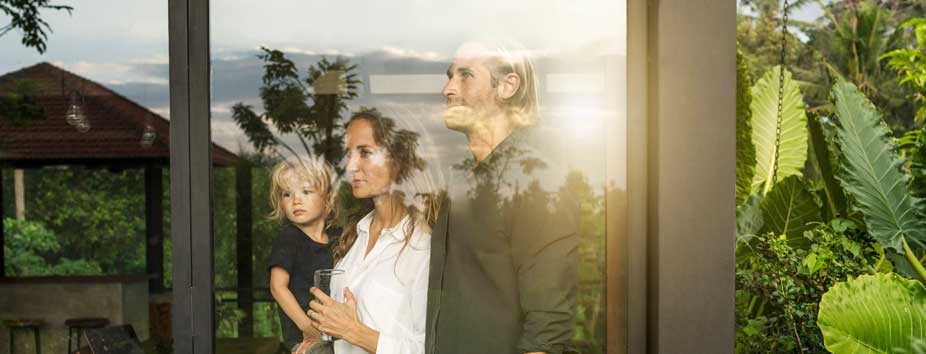May 2023 – 8 minute read
What you'll learn
1. Should you consider riding a bike to work?
The benefits
It may help save on the costs associated with running a car, or using public transport, not to mention the positive effects it could have on your fitness. There could also be social benefits, potentially meeting other like-minded cyclists through clubs and online forums.
What could you do to make the switch? Suggestions from our partner Cogo:
Got a bike?
If you don't already have a bike, consider borrowing one, trialling a ride-share bike if they're available in your city or getting a second-hand one. No matter the bike you choose to use, check it's safe and roadworthy. At the minimum, check chains, brakes, and tyres. An overall service by your local bike store is a good idea.
Safety gear
You've got the bike and had it checked. Now, to the gear. A helmet is a must, followed by a light and reflectors for night rides, sturdy shoes, rain, or wind protection, and even eyewear.
The route
Will you ride on the road or on designated cycling paths? Are there lots of hills? How long's the trip? Ensure you consider whether riding a bike would be the best option for you.
Rules and regulations
No matter what, always check what rules apply in your state or local area. Cycling forums or enthusiast clubs could be a source of helpful information.
Measure your carbon footprint with the Westpac App
The progressive rollout of our new Carbon Footprint Tracker feature has begun. Watch out for it on the home screen of your Westpac App.
Small changes may have big impacts on your carbon footprint over time. Understanding where and how you spend if you want to make decisions that could help reduce your carbon footprint.
2. Why choose public transport?
The costs
The total costs of road congestion in Australia’s large cities will be $38.8 billion per annum in 2031, with the transport sector being the third-largest emitter.^ Cars are responsible for about half of these emissions, with the average car producing 330g of CO2e per person per kilometre driven compared to just 4g for an electric bus and 42g for a metro train over the same distance*. When you weigh up the costs, using public transport instead of driving a car to get to the same destination, where possible, could result in a significantly lower carbon footprint for that trip.
What could you do to make the switch? Suggestions from our partner Cogo:
Take public transport
If there are good public transport networks close by, leaving the car at home, even on a few of your travel days, will have an impact on the amount of personal carbon emissions you’d produce for that trip, compared to using your car.
Research and plan
Convenience is everything when commuting. An online journey planner or app will help you find the fastest route and the frequency of services. A well-planned public transport route may mean avoiding the hassles of driving in peak-hour traffic or fighting for a parking spot.
Extra free time
When travelling on public transport, it could be a great opportunity to read a book, catch up on emails, check your social media, or even take a power nap.
Share your journey
If public transport is not viable, carpooling, carsharing and ridesharing could be other options. You'll get extra cars off the road, reducing carbon emissions and your travel costs. And there’s the social side, meeting people who live, work or study in your area.
Electric car loan
Want a new or used electric or hybrid car to reduce emissions and running costs? You might consider a Westpac Car Loan, as special rates apply to all eligible electric or hybrid vehicles.
3. Could repairing your clothes reduce your carbon footprint?
The benefits
Extending the life of an item of clothing by an extra nine months could reduce its carbon, waste, and water footprint by around 20-30%*. If you’re not handy with a needle and thread or a repair is beyond your skill set, you could use one of around 700 Australian businesses that specialise in clothing and footwear repairs.*
What could you do to make the switch? Suggestions from our partner Cogo:
Repair, recycle or sell
Sorting through your wardrobe as the seasons change is a great way to work out what still fits, what you could repair, what you could recycle by donating items to family, friends, or charity, or what you could resell.
DIY or professional
Decide what clothes you'll be able to fix at home and those you'll need to get professionally repaired. Someone in your social network may have the skills to help with repairs or could recommend local tailors or alteration specialists in the area.
Sustainable brands
Some brands seek to improve their green credentials by offering repair services or instructions on repairing them yourself. They may offer a way for you to resell items in good condition that you no longer need.
Buy vintage
Shopping in thrift stores or buying preloved items is also a great way to extend the life of an article of clothing.
Westpac Carbon Footprint Tracker
The progressive rollout of our new Carbon Footprint Tracker feature has begun. Watch out for it on the home screen of your Westpac App.
Our Carbon Footprint Tracker in the Westpac App could help you understand and keep track of your spending habits and estimated carbon footprint.
4. How every minute counts when taking a shower
The costs
Older-style shower heads can use about 15-20 litres of water a minute, while the average bath uses about 150 litres*. In times of drought and water rationing, that could have a considerable impact on our economy and the environment as energy and resources are required to produce a clean and reliable water source*.
What could you do to make the switch? Suggestions from our partner Cogo:
Water efficiency
Switching to appliances or programs that use less water per cycle or fitting a flow restrictor to your taps may help reduce the carbon emissions associated with providing a clean water supply, and as an added benefit, lower utility bills. A 5-minute shower with a water-efficient shower head typically only uses 40 litres, which not only conserves water, but could save up to 50% of the total carbon emissions associated with treating, supplying and heating the water.*
Water wise habits
Not leaving the tap running whilst brushing teeth or shaving, using the toilet half flush, or filling up the sink to wash up might seem insignificant, but over a day, you'd be surprised how much water you could save. And if you combine that with a cooler water temperature, you could lower your footprint and be kinder to your skin.
Shower vs bath
You can't go past a bath for relaxation, but you could make changes by reducing the water temperature or running the bath level a bit shallower. For everyday showering, keeping track of time can be tricky, so why not set a timer or play a song that's around 5 minutes long?

5. What to consider when cooling and heating your home
The benefits
Insulating your home, using energy-efficient windows and doors as well as window and floor coverings, in conjunction with energy-efficient heating and cooling systems, could produce significant savings for your energy bills. For every one degree you increase your heating or decrease your cooling, your energy use will increase by approximately 5-10%*, meaning small temperature changes could potentially save you money on your heating or cooling bills.
What could you do to make the switch? Suggestions from our partner Cogo:
Ideal temperatures
You could set your household temperature at 18-20°C to keep warm in winter and between 25-27°C to keep cool in summer. By closing blinds, curtains, and doors, you’ll be able to reach your ideal temperature faster, by using less energy. And by installing a smart thermostat, you could potentially shave 10-15% off your heating and cooling costs.*
Setting timers
Efficiency and saving energy are all about working smarter. Setting your air conditioning or heating to switch off automatically overnight or when you know you’ll be away from home means you’ll only be consuming energy when you need it, cutting costs and emissions.
Energy efficiency
Maintaining or servicing your system may help your heating or cooling to run more efficiently. Cleaning filters regularly and checking for leaks in ducting or insulation means you’ll maximise efficiency and save money by extending the life of your existing system.
Solar personal loan
Going solar could reduce your energy bills. You could apply for a personal loan for up to $50,000, with no security needed and rates that are personalised to your needs and credit rating.
6. Is composting the answer to reducing food wastage?
The cost
Food waste sent to landfill decomposes poorly due to a lack of oxygen, releasing harmful gases into the atmosphere, with global food waste producing 8% of total greenhouse emissions*. If food waste were a country, it would be the third largest emitter, so a practical solution to reduce food waste might be to make a weekly meal plan so you only buy what you need. Then any food scraps you could turn into compost. Compost is not only great for the plants in your garden by helping to improve the soil and lock in moisture, but it decomposes aerobically, which produces mainly CO2, and not the more harmful methane*. Additionally, but also importantly, this reduces the volume of waste going to landfills, reducing transport emissions.*.
What could you do to make the switch? Suggestions from our partner Cogo:
Where to start?
A great place to start is in your kitchen. We're all used to recycling, so composting and taking out the food scraps we usually throw away would mean another container for most of us. After that, you'll need to consider what you want to do with the scraps.
Composting
You could buy a specially designed compost bin from a hardware supplier or make your own. Depending on what you want to do with your compost, from adding it as mulch or bokashi (a super-fertile compost) to your garden, or using it to start a worm farm, will dictate what food scraps you should save. Learn what you could compost, from fruit and vegetable scraps to coffee grounds and eggshells and, importantly, what you could add to your compost, including meat scraps, dairy, fats and oils.+
Other alternatives
If composting's not your thing, consider some of the more ingenious uses, such as retaining seeds, pits, and cuttings from your veggies to grow more of them, using scraps to create sauces, jams, and broths, using cucumber peelings to deter ants, or making breadcrumbs from stale bread.

